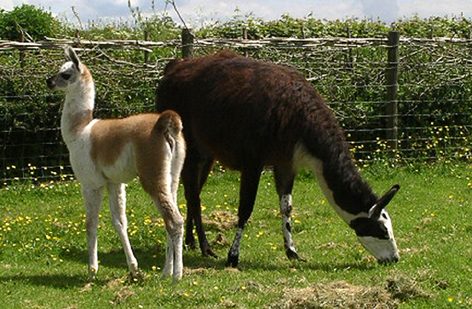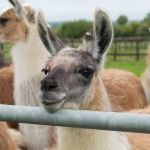Buying & Breeding – Llamas for Sale
Catanger llamas are not just for trekking they are also for sale. We sell them fully trained – visit our herd and find the right llama for you!
We chose our foundation stock with great care so are of top quality and our success in the show ring bears this out, having won many championships for more than 20 years.
Llamas may live for 20 years so it is vital to start off with the right one for you. We only sell haltered and trained llamas that are a minimum of 15 months old and we will teach you to handle them confidently and safely so that you can enjoy them from the first day. As we have a herd of around 50 llamas you should be able to find the right one for you.

Buying a Llama
Why Llamas?
Llamas should never be kept on their own, they need a llama companion. Two females or two geldings are best.
If you want to breed llamas then be sure you have the right facilities and enough land to keep them all and to separate them safely. Buy the best quality you can afford. Research and learn as much as you can before you buy to help you make the right selection.
Trekking llamas need to have a temperament that is suited to the task and also conformation that will allow them to work well into their teens.
Temperament is the most important factor to take into account if you want a field pet. Some llamas may look cute and cuddly, but that doesn’t mean a thing if you can’t get near it! Females will enjoy going out for walks and can be trained to carry a pack just like the boys, there is then the option of breeding at a later date.
If they are to guard or to be a companion to other livestock then a single llama may be fine providing he (must be a male) is the right age. No younger than 18 months old so past babyhood, but no older than 4 years as that is when they reach maturity. He must have been raised in a herd of llamas so that he knows he is a llama and that he is a protector of the herd. He must never have been used for breeding and should be castrated. To protect free range poultry, two llamas are best.
How much land will I need?
Recommended stocking rate is 4 llamas per acre. However, this does not mean you can keep two llamas on half an acre, as pasture needs to be managed and is best divided into a minimum of two paddocks so that one can be grazed whilst the other is rested. This helps to graze more efficiently and helps to keep internal parasites to a minimum. Llamas also need space top roam and play, keeping them in very small paddocks can cause stress and boredom, effecting their behaviour. Two llamas need a minimum of one acre.
What about fencing?
Standard stock fencing is adequate. Although llamas are capable of jumping five bar gates from a standstill, they almost always respect a barrier. Keeping a breeding male alongside females would be asking for trouble and if your land borders a busy road then a slightly higher fence would be sensible. Electric fencing is usually respected if strip grazing or protecting hedges. Hedges will be eaten and also some trees as llamas are browsers and will try most vegetation.
Do they need a shelter?
Yes please. Although very hardy animals, a shelter from the heat/wind/storms are appreciated. A shelter will also provide a dry area to put their hay in which must be provided ad lib all year round. It will also give you an area to catch them and to carry out any husbandry tasks. A simple three sided shed is adequate with a gate on one side to enclose them when necessary.
What do they eat?
Grass and hay. Too many llamas are seriously overweight as owners will insist on feeding them supplementary feed that they simply do not need. Some pregnant or lactating females may need extra food as do some geriatric llamas and weanlings. Learning how to gauge body condition is the key to knowing if and when you need to feed hard food.
What health care and husbandry is required?
Very little! One of the easiest animals to keep. Naturally hardy and healthy. Vaccination against clostridial diseases given as annual boosters. Worming only when faecal samples dictate. Most llamas never need their toe nails clipping and some short fleeced llamas will not need shearing. Longer fleeced animals will benefit from shearing every 2–3 years.
How long will they live?
Average age is 15–20 years, some llamas living into their twenties. Definitely not just for Christmas.
Are there any illnesses, health issues or special licences for keeping llamas?
No licences required. At present, no compulsory movement records need to be kept as they are not classed as agricultural animals. In the case of National movement restrictions (Bluetongue/Foot and Mouth outbreaks) camelids are subjected to the same movement regimes as other farm livestock until the outbreak is over. The UK has an increasing problem with Bovine TB and camelids can get this awful disease. There are several TB hotspots in the UK and moving an animal out of these areas into clean ones should be undertaken with great consideration and advice from your vet. Check the DEFRA web site to identify these areas.
Can I train my own llama?
Unfortunately, too many people buy young, untrained llamas that they hope to train themselves. It is not the same as training a dog or even a horse and too many new owners fail to handle their llamas in a way that gives them, or their llama much enjoyment. If your first llamas are already trained and you learn how to handle them confidently, you will be able to enjoy them from the start and for many years to come.
How do you transport a llama?
Llamas are easy to transport. They do not need tying up, rugging up or their legs bandaged. Once underway, they lie down and enjoy the trip. A horse trailer or livestock trailer is the only way to travel with llamas. Do not use transit vans or any vehicle not designed for large animals. Legislation on transporting animals can be found on the DEFRA web site.
Looking for the right llama for you?
Try to see as many llamas as you can, get a feel for what you like and what you dislike. Remember that if you want to handle them, they must be trained and you must learn it too. They vary in size and fibre coverage. A long shaggy coat may look gorgeous but will take more shearing and looking after. A big llama may look daunting but could well be easier to handle than a smaller one, temperament, training and help from the breeder are paramount. Sooner or later, you will find what you are looking for – or maybe he will find you!
The Catanger Difference
Good conformation and ‘true to type’ qualities are our goals in the Catanger breeding programme and our success in the show ring bears this out. All our llamas are registered, micro-chipped and vaccinated for Clostridial diseases. We do not offer them for sale until they are fully halter trained and trekking confidently off the farm. We do not sell baby llamas that are newly weaned.
We allow our mothers to rear their youngsters without any human interference and only start to handle the crias (baby llamas) just before weaning at about 6 months of age. This ensures that they develop all the right llama characteristics, gentle, non-aggressive and very inquisitive. Over-handling of young llamas can lead to behavioural problems later on, especially with males, so our training begins once they are passed the baby stage and ready to discover the world. Once halter trained and leading well, they complete their training by accompanying our experienced trekking boys out on treks to give them experience of meeting new situations.
We encourage all prospective buyers to come and have as much on farm training as they require which includes haltering, handling, leading, trekking, grooming, llama husbandry and management. After sales help and advice is always there for you as we want our llamas and new owners to have long and happy lives together.
Our training days include instruction on llama conformation and if showing llamas is one of your goals, we can help you to develop your show ring skills so that you know how best to present your llama to display his or her best qualities.

How Do I Buy from you?
Come and visit our herd. See what our llamas look like and how they react with people. After catching and haltering a couple of llamas, see how it feels to lead a well trained llama for yourself, maybe you have never lead a llama before. There is no obligation to buy.
If you later decide that you would like one of our llamas, we can arrange for you to have some training on the farm that will give you the chance to get to know and handle the ones for sale. You will learn all the things you need to know to handle a llama competently and somewhere along the way you will discover which ones would best for you.

Llamas for sale

Zoom (gelded trekker) Born 2021

Skoot Born 2023

Gino (gelded trekker) Born 2021

Billy Dick (gelded trekker) Born 2021

Born 2022 (trekker)

Born 2022 (trekker)


